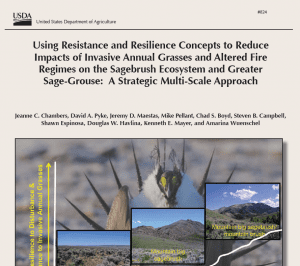Fire Regimes
View report.
This report provides a strategic approach for conservation of sagebrush ecosystems and greater sage-grouse that focuses specifically on habitat threats caused by invasive annual grasses and altered fire regimes. It uses information on (1) factors that influence sagebrush ecosystem resilience to disturbance and resistance to invasive annual grasses and (2) distribution, relative abundance, and persistence of sage-grouse populations to develop management strategies at both landscape and site scales.
View article.
In this study, researchers compiled landscape-scale evidence of historical fire severity patterns in the ponderosa pine and mixed-conifer forests from published literature sources and stand ages available from the Forest Inventory and Analysis program in the USA. The consensus from this evidence is that the traditional reference conditions of low-severity fire regimes are inaccurate for most forests of western North America. Instead, most forests appear to have been characterized by mixed-severity fire that included ecologically significant amounts of weather-driven, high-severity fire.
View review.
This review examines the effects of disturbances, such as grazing, and changes in climate on resilience and resistance of cold desert shrublands that span temperature and precipitation gradients across the western United States. It demonstrates how to use information about cold desert resilience and resistance to help manage this ecosystem and describes the benefits of using protection, prevention, restoration, and monitoring strategies to determine priority management areas and appropriate management actions.
View article.
This study examined stand structure and development of mixed-conifer ecosystems in the south-central Great Basin where pinyon (Pinus monophylla) and juniper (Juniperus osteosperma) are found together with other species, such as ponderosa pine (Pinus ponderosa). Because wildfire regime and land-use changes were not identical between the study sites, and increases of pinyon-juniper populations have occurred in other Great Basin areas at about the same time, climate was the most likely driver. Therefore, pinyon-juniper woodlands, which have recently experienced dramatic episodes of climate-related dieoffs in regions where pinyon is present, have not been negatively impacted by climate in the Great Basin, where the pinyon species is Pinus monophylla.
View article.
This review proposes a classification framework for aspen that is defined by key fire regime parameters (fire severity and probability), and that reflects underlying biophysical settings and correlated aspen functional types. Five aspen fire regime types are proposed: (1) fire-independent, stable aspen; (2) fire-influenced, stable aspen; (3) fire-dependent, seral, conifer-aspen mix; (4) fire-dependent, seral, montane aspen-conifer; and (5) fire-dependent, seral, subalpine aspen-conifer.
View brief.
This research brief reports that the cessation of fire use by Indians and a shift to climatic conditions less favorable to fire are both explanations for decreased fire frequency over the past century and a half in the southern Great Basin and Mojave desert ecotone.
View report.
This report found that big sagebrush recovery following fire over a broad regional scale suggests an average recovery time of 25 to 35+ years. However, there was much variation in recovery rate associated with the timing of precipitation relative to the particular fire event. We found that precipitation in the pre-fire growing season was positively related to post-fire recovery of mountain big sagebrush, and that precipitation in the late winter following fire was similarly positively related to recovery rate.
View article.
This Nature article discusses large, severe fires, climate change, insect outbreaks, and recovery of western forests with USGS scientist, Craig Allen and WERC scientist, Nate Stephenson. on the conversion of forest ecosystems due to climate change and altered fire regimes.
View report.
This report outlines a range-wide strategy for maintaining whitebark pine populations in high mountain areas based on the most current knowledge of the efficacy of techniques and differences in their application across communities. The strategy is written as a general guide for planning, designing, implementing, and evaluating fine-scale restoration activities for whitebark pine by public land management agencies, and to encourage agency and inter-agency coordination for greater efficiency. The strategy is organized into six scales of implementation, and each scale is described by assessment factors, restoration techniques, management concerns, and examples.
View synthesis.
This synthesis investigates the resistance and resilience differences among the cold and hot desert shrublands of North America. Differences are largely determined by spatial and temporal patterns of productivity but also are affected by ecological memory, severity and frequency of disturbance, and feedbacks among invasive species and disturbance regimes. Strategies for preventing or managing invasive plant/fire regimes cycles in desert shrublands include: 1) conducting periodic resource assessments to evaluate the probability of establishment of an altered fire regime; 2) understanding ecological thresholds associated within invasion resistance and fire resilience that characterize transitions from desirable to undesirable fire regimes; and 3) prioritizing management activities based on resistance of areas to invasion and resilience to fire.



